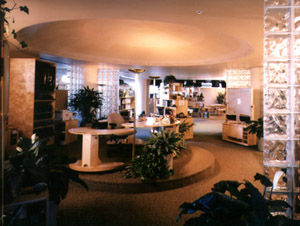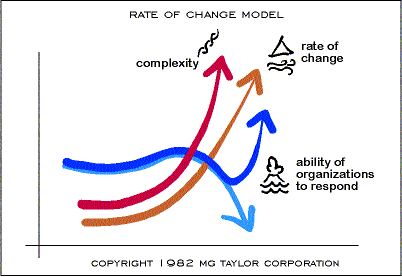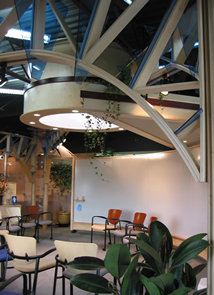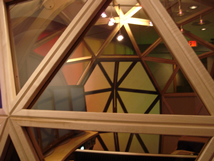|
|

What is a Management Center System?
Enterprises build and employ Management Center™ systems
to transform the way they work to match and exceed the
demands of our high-speed information culture. They do this by integrating work
process design, innovative architecture, technical systems and information management--tools,
process and environment. Management Centers represent a systematic reinvention
of the way people think, decide and work together to accomplish organizational
goals. Management Centers provide organizations with an enhanced capacity to
anticipate, plan, and act.

Management Center systems provide Transition Managers with
the proper tool to manage all of the Seven
Domains as a total system:
-
growing and adapting the body of knowledge required to model
the internal and external environment and then create appropriate organizational
responses
-
facilitating the processes of decision making, design, the
way work gets done individually or with others in order to release group genius--the
genius that provides the enterprise with a competitive and cooperative edge
-
creating education systems to help organizations explore
beyond their current boundaries of performance and invention, and training
systems to set the memes of new performance standards quickly throughout the
complexities of the value web
-
employing environments that allow individuals and groups
to see the whole picture and the details, to collaborate effectively, work
individually, and change configuration within a matter of minutes to accommodate
the expansion or contraction of ideas, groups, plans and designs
-
using technical systems to leverage education systems and
more rapidly adapt the body of knowledge to the external business, social,
technological and political environment--so much so that truly effective organizations
have a greater hand in creating the external environment, and doing so in
a responsible, healthy way
-
managing projects collaboratively with less waste, more innovation,
and an ability to see into the "white space" between activities--the
place where unanticipated opportunities are mined and unforeseen disasters
averted
-
managing the entire value web as a venture, including dozens
or thousands of individuals and other organizations into a synergistic whole,
each part maintaining its identity and ability to lead sapientially, while
contributing to the work of the whole and the other parts
Management Center systems were invented to address the specific
technological, social and economic conditions and opportunities facing organizations
now and in the future. In their broadest terms, these conditions are characterized
by a rapid and accelerating rate of change, and the inability of most organiations
to effectively respond to that rate of change through traditional (typically
incremental and linear) approaches.

click on model for more information |
The technology that both brings us all closer together, yet separates
us even from those sitting next to us allows a web of activity to be woven. The transfer
of information, matter and energy across this web ratchets up the level of total
system complexity, which in turn drives the rate of change (as more individual nodes
share information, the level of innovation and invention increases). Organizations
employ structures designed to help them fill niches in their environments. These
structures remain entirely requisite unless the rate of change in the environment
eclipses the flexibility of the structure. In this case, the organization may respond
with either a nose dive into oblivion or a turnaround inspired by structural redesign.
In order for organizations to thrive and grow int this environment
they need capacities that Management Center systems provide, like these:
-
the ability to anticipate and track internal and external changes
-
the ability to respond quickly and appropriately to new conditions,
and thus "turn turbulence into opportunity"
-
the ability to readily reconfigure internal operations to meet
changing demands
-
the ability to align members of an organization to address new
challenges
-
the ability to design new processes and develop the conditions
to support high-performance
-
the ability to master complexity, and continually be able to discern
the critical events and trends in an era of information overload
-
the ability for each individual to see the whole as well as the
parts, and to apply a systems perspective to their work
MG Taylor operates its own centers in Hilton Head, South Carolina, and Palo Alto, California. We have developed a
number of Navigation Center™ systems
for our clients, including Borgess Health Care Alliance, Detroit Edison Energy,
Continuum Health Partners, NASA, the United States Air Force F-15 project, and
Arnold Engineering Development Center.

copyright © 1997, MG Taylor Corporation.
All rights reserved
copyrights,
terms and conditions
19970708151223.web.bsc
|
| The “Legacy” MG Taylor Web site was active from 1995 through 2002. It was primarily developed for the growing network of KnowledgeWorkers who supported our work and the clients who employed it. |
| The description of the MG Taylor Management Center provides a simple background to some aspects of the MG Taylor System and Method which was issued a U.S. patent in 2001 and from Canada in 2009. Several applications are in pending in various countries. |
Since 1980, MG Taylor has built, based on our unique methods, over 30 collaborative environments - we call them navCenters™ today - and there are now a dozen projects in progress. The WorkPlace at the World Economic Forum is based on our work. Our focus over the last 10 years has been to develop our capacity to design, manufacture, build and transfer the operation of NavCenters to both providers of the process and clients for their own internal use. Over 3,000 DesignShop℠ events have been provided to organizations of all kinds, all over the Earth by MG Taylor and licensed practitioners. There now exists a global ValueWeb℠ of KnowledgeWorkers who do this work. MG Taylor can be contacted for a list of those who are certified and can match you up with the best team given the nature of your challenge. MG Taylor provides DesignShops when complex, systemic, cross organizational issues are involved and or when this is a path to transferring the process to new license holder.
|
| We no longer operate facilities of our own as we have access to a number of client environments around the world. This provides us needed facilities and also the opportunity to continue the transfer process on a regular basis.We do maintain a RDS™ (rapid deployment solution) system which is a navCenter which can be set up anywhere for work ranging from several days to weeks. |
| A new web site is launched which maintains links to several of our legacy sites and where updates such as this one are posted. These legacy sites still enjoy robust traffic and constitute a partial history of our enterprise. The purpose of this new site is to report ongoing activities, address ValueWeb issues and continue publishing information and models related to our work. In time, the new site will become a direct portal to many of our goods and services. |
| The core of the Taylor method has always been the tight integration of physical environment, work processes and augmentation tools. This remains so. We focused primarily on the process through the 80s and 90s, the environment over this last decade and now - because of recent developments in technology providing powerful, consumer affordable systems - we are returning to the augmentation part of the system. We call this upgrading and reinvention of our entire suite of environments, processes and tool kit the nextGen Project and expect the result to be as much an advance on present practices as our work in 1980 was on the then prevailing methods. |
| The following links, click on the pictures, provide images and information about the history and present state-of-the-art of navCenters: |
 |
MG Taylor, tsmARCHITECTURE, and AI, team up with a ValueWeb of designers, artists, engineers and builders to make these unique environments. Each is designed with a client sponsor team to transform a general “engine of creation” into a specific project fit for a time, place and unique organizational mission.
Some navCenters are for internal use only. Others for working with customers and community. navCenters have been built for corporations, nonprofit NGOs, governments, military, schools, hospitals, manufacturing facilities, office environments, design companies. What is common to all of them is that the navCenter is designed to bring a new way of working to the enterprise. The goal of this this new way of working is to leverage the GroupGenius℠ of the entire enterprise. By doing so, complexity can be met, divisions healed, cross organizational disputes resolved and enormous time and costs removed from the process of taking an idea to market. The average return on a navCenter is thousands of times the cost.
These environments have been developing the “design economy” for decades. In doing so we have amassed a rich knowledge-base about human creativity and innovation. This growing knowledge is built into - embedded - in each new project with the ValueWeb of users and environment makers continually sharing new means, new ideas and capacities. This is a leaning system. Instead of backing into the future looking in the rear view mirror, It is possible to create “a future by design, not default.” Not a static, linear, over designed future that is dead on arrival but an evolving, emergent response to an ever changing world.
This remains the vision and the practice as we enter our fourth decade of making these environments. |
|
 |
 |
 |
 |
| Projects are underway for a new navCenter in Vienna, a school expansion in Calgary, and VA Learning Exchanges (their term) in Orlando, Salem, Salisbury and several other sites. Visit What’s New on the MG Taylor site. |
|
|
|

